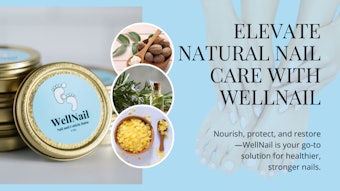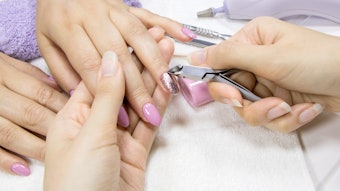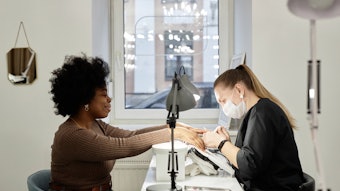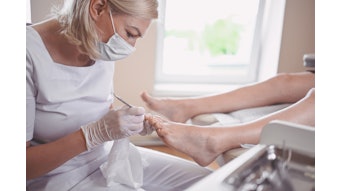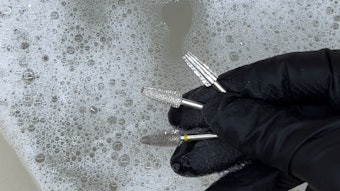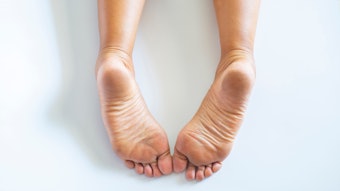
Proper product purpose and ingredient education are key to delivering and nurturing both long-term nail growth and long-term client loyalty within your nail care business. While the primary function of the nail plates is to protect the tips of the fingers and toes, humans use them to pick up small objects, and though inappropriately, sometimes they serve as tools, causing damage to them. When adorned with nail polish, nail plates serve as self-expression vehicles and make most humans feel good. To describe a human nail as a structure consisting of a nail plate attached to the tip of a finger for its protection and function is an oversimplification, as shown in Figure 1. When consumers speak of nails, it is understood that they are referring to the nail plate. Nail plate will be used as the proper terminology in this article.
 To describe a human nail as a structure consisting of a nail plate attached to the tip of a finger for its protection and function is an oversimplification, as shown in Figure 1. When consumers speak of nails, it is understood that they are referring to the nail plate.FIGURE 1 AND 2 ILLUSTRATIONS BY IV_DESIGN AT ADOBE STOCK
To describe a human nail as a structure consisting of a nail plate attached to the tip of a finger for its protection and function is an oversimplification, as shown in Figure 1. When consumers speak of nails, it is understood that they are referring to the nail plate.FIGURE 1 AND 2 ILLUSTRATIONS BY IV_DESIGN AT ADOBE STOCK
Physical and Chemical Composition of the Human Nail Plate
The human nail plate has the same chemical composition as human hair. Both are made chiefly of keratin fibers with similar amino acid composition. Lipids, mainly cholesterol, are present at 0.1-1.0 %, and water at 7-12%. Minerals represent an insignificant portion of the nail plate’s composition.
There are three distinguishable layers comprising the nail plate (see Figure 2): the layer touching the nail bed is called the ventral (bottom) layer, the layer exposed to the air we see is called the dorsal (upper) layer and sandwiched between them is called the intermediate (middle) layer. The intermediate layer is the thickest, followed by the dorsal layer.
 There are three distinguishable layers comprising the nail plate (see Figure 2): the layer touching the nail bed is called the ventral (bottom) layer, the layer exposed to the air we see is called the dorsal (upper) layer and sandwiched between them is called the intermediate (middle) layer.FIGURE 1 AND 2 ILLUSTRATIONS BY IV_DESIGN AT ADOBE STOCK
There are three distinguishable layers comprising the nail plate (see Figure 2): the layer touching the nail bed is called the ventral (bottom) layer, the layer exposed to the air we see is called the dorsal (upper) layer and sandwiched between them is called the intermediate (middle) layer.FIGURE 1 AND 2 ILLUSTRATIONS BY IV_DESIGN AT ADOBE STOCK
The keratin fibers, also called filaments, in the intermediate layer are well packed horizontally in the lateral direction, perpendicular to the axis of the nail plate’s growth, whereas keratin fibers in the dorsal and ventral layers are randomly packed like overlapping tiles, as shown in Figure 3. This alignment of keratin fibers and the many disulfide cross-links, due to the high proportions of the amino acid cystine, most likely contribute to the nail plate’s toughness. The packing quality of the keratin fibers in the dorsal layers could vary with everyone. It might be a factor in the resistance or susceptibility of the nail plate to superficial surface damage caused by using long-wearing nail polish products. This correlation has yet to be investigated.
 The keratin fibers, also called filaments, in the intermediate layer are well packed horizontally in the lateral direction, perpendicular to the axis of the nail plate’s growth, whereas keratin fibers in the dorsal and ventral layers are randomly packed like overlapping tiles.Courtesy of IV_DESIGN AT ADOBE STOCK
The keratin fibers, also called filaments, in the intermediate layer are well packed horizontally in the lateral direction, perpendicular to the axis of the nail plate’s growth, whereas keratin fibers in the dorsal and ventral layers are randomly packed like overlapping tiles.Courtesy of IV_DESIGN AT ADOBE STOCK
Understanding Your Scope as a Nail Tech
Diagnosing conditions, such as microbial infections caused by bacteria, yeast, mold or fungi, allergies and disorders due to medical reasons, are out of the scope of nail techs’ license. The treatment of these conditions will not be addressed in this article. It is sufficient to say that the diagnoses and treatment for these conditions must be left to a licensed medical practitioner. Nail techs should not provide nail services to clients whose nail plates and the skin surrounding them visually manifest abnormality that could be linked to these conditions without a physician’s written release, to eliminate the possibility of aggravating the condition or spreading the infection to other clients.
What about cosmetics suppliers offering products that address nail plate issues raised by consumers? Any product that claims to treat a medical condition is not a cosmetic, but a drug. It must go through the FDA's new drug application process for certification as an over-the-counter (OTC) product before it is sold to the public. OTC products have a National Drug Code (NDC), an 11-digit number displayed on their packaging.
The Federal Food, Drug, and Cosmetic Act defines cosmetics as “articles intended to be rubbed, poured, sprinkled, or sprayed on, introduced into, or otherwise applied to the human body for cleansing, beautifying, promoting attractiveness, or altering the appearance…” Any product marketed with therapeutic claims is in violation. Cosmetics manufacturers must comply with MoCRA (Modernization of Cosmetics Regulation Act of 2022).
What Should I Use to Treat the Nail?
In this section, I will address the consumers’ desire for strong nails and loosely use the term treatment to alleviate nail plate conditions within the nail techs' scope of practice.
Why is it acceptable to use the term treatment? The nail plate has no vascularity or metabolism characteristics, unlike living cells. In other words, its cells are considered dead. What we apply to it is cosmetic.
A professional manicure consists of the following in the order of their application to the nail plate:
1. Nail Prep or Primer (removes residual oil or moisture for better adhesion of the next layer)
2. Base Coat (first film-forming layer for universal adhesion to the nail plate)
3. Ridge Filler (sometimes the Base Coat is also a ridge filler)
4. Color Coat (lacquer, varnish and polish are synonymous terms used)
5. Top Coat (to provide high gloss, color protection and sometimes to dry the lower layers quickly)
This application sequence indicates the Base Coat's importance. It is an adhesive layer that could shield the nail plate from staining, due to the polish. Treatment ingredients should be incorporated in the first layer touching the nail plate, meaning the Nail Prep or Primer, unless this layer is permeable to the ingredient. Therefore, when not a Nail Prep component, the treatment ingredient must be in the Base Coat for direct contact with the nail plate. If incorporated in the next layer, the Base Coat must be permeable to the ingredient to reach the nail plate and work.
What's the Difference Between a Nail Strengthener and Nail Hardener?
Lucky are individuals who have naturally hard and resilient nail plates. Rigid nail plates could be dry, brittle and break easily with minor trauma, whereas bendable nail plates would resist breakage. Some bendable nails experience delamination of the dorsal keratin layers. Individuals looking for nail strengthener products usually have bendable nail plates.
To better understand how to address what consumers are looking for when they say they have weak nails and want a strengthener, I will differentiate a nail strengthener from a nail hardener in the following manner:
A nail strengthener would provide physical protection against trauma to a healthy nail plate. In this context, a professional manicure described above is a nail strengthener while on the nail plate. The multi-layered dry polish will keep the bendable nails rigid. Rigid but dry and brittle nail plates could benefit from a nail treatment product offering hydration and nourishing ingredients to render some flexibility to the nail plates, as mentioned in the next section of this article.
A nail hardener has ingredients that could bind to the keratin fibers and form cross-links. Ingredients that form chemical bonds are formaldehyde, anhydrides, alkyl amines, unsaturated compounds (such as acrylate/methacrylate monomers) and thiols. These have been used to treat hair with split ends. These ingredients lead to brittle nail plates that break and split easily when overused.
Growing Healthy Nail Plates Naturally Is Possible
Outside of having good genes, a healthy lifestyle and diet could be all that one needs to achieve strong, healthy nail plates. In this case, lifestyle includes routine care and grooming of the nail plates. A diet to help grow healthy nail plates would consist of a nutritional balance of proteins, vegetables, fat and carbohydrates from various sources and contain biotin, vitamin D3, Vitamin B-12 and minerals. These nutrients are essential for the nail matrix's normal function, as it feeds the nail root and, consequently, the nail plate.
When the above is insufficient, nail care products with ingredients deposited on the nails for hydration or nourishment may be necessary. Still, they must be applied daily and consistently, even when the nail plate is polished. These products are available as oils, serums, lotions and creams fortified with ingredients such as plant oils, vitamins, peptides, hydrolyzed protein, plant extracts, antioxidants, hyaluronic acid, fruit acids, etc. that keep the nail plate and surrounding skin hydrated and pliable. These ingredients may also be added to fortify the first product contacting the nail plate in the professional manicure, as described above.
In determining which base coat or treatment is right for each client, proper product purpose and ingredient education is key to delivering and nurturing both long-term nail growth and long-term client loyalty within your nail care business.
About the Author
Vivian Valenty, Ph.D. (@nailpolishdoc), is the founder and president of VB Cosmetics, the creator and manufacturer of Dazzle Dry. She is also a member of Nailpro’s advisory board. She obtained her doctorate in chemistry from Penn State University, and, for the past 33 years, has been creating products for the professional nail industry.



